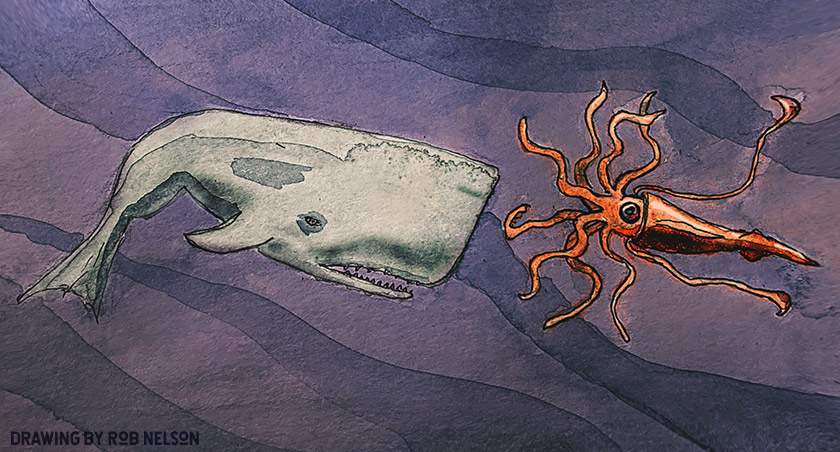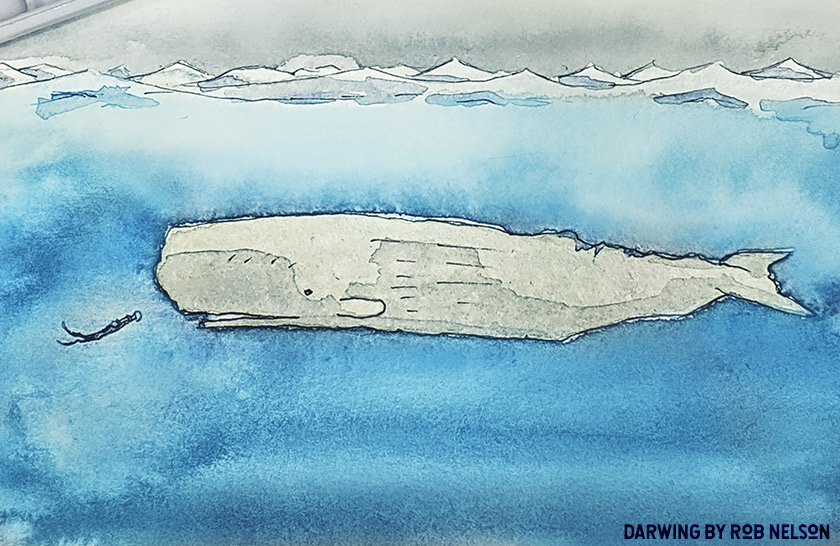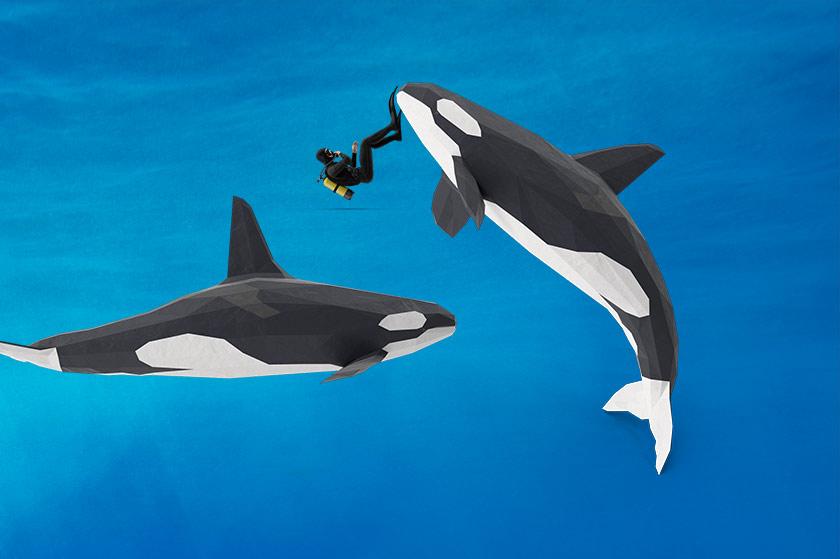Avoiding Whale Attacks and Aggression


Do whales attack people? Actually, there is some evidence they have, even if very rarely. More on that below.
Are whales and dolphins out to get you? No way. We know that now, but not everyone thought like we do.
Imagine for a second that you live in the eighteenth century. The seas are a wild and untamed frontier full of dangerous creatures. All you know of whales is from reading the account of the white whale in Moby Dick. Maybe you also know the Old Testament account of Jonah, who was literally swallowed by a whale. From these stories alone, you may get the biased impression that whales are extremely dangerous beasts of the sea.
Fortunately, we have a lot more accurate information to guide our opinion about whales today! Modern Sea World shows, aquariums, BBC specials like Blue Planet and current bans on whaling have changed most people’s views of whales. Maybe our view of whales now is a bit more aligned with the truth about these massive animals. Whales are beautiful, massive and extremely intelligent, so it’s worth sorting the truth from the fiction.
Cetacean Basics:
What you need to know about Whales and Dolphins
There are 90 species of whales and dolphins which collectively we call cetaceans. They range from the tiny 4.5 foot Vaquita to the massive blue whale. Blue whales are the largest animals to have ever lived on this planet. An adult blue whale can weigh 190 tons and reach 110 feet long – which, for perspective, is about 3 school busses end to end! In fact, we should feel pretty lucky that 1) we live in this time to witness them and 2) that we didn’t hunt them to extinction… because that did nearly happen.

Most whales eat very small prey, from tiny fish to small shrimp-like organisms like krill. They filter feed these organisms from the ocean. Because of this diet and the fact that they didn’t evolve with humans in any practical sense, these whales aren’t interested in humans other than out of curiosity when we show up.
I suppose, in theory, they could engulf a human in their mouths, but they’d never get them into their stomachs. Their throats are very small due to what they normally eat.
This very fact seems to put the story of Jonah and the whale in a very different context. More likely the story is a metaphor about battling your demons than it is actually battling a real whale. But let’s just say for a second, it was. What whale would it have been? It has to be a whale capable of swallowing a human.
Now is when the sperm whale stories start to get interesting. Moby Dick for instance, is a fictional story that apparently came from two true events. One was a tale of a legendary white whale that was spotted by someone. A white whale is significant because most sperm whales are grey. The story of a whale sinking a ship came from captain George Pollard. In 1820 he captained the whaling ship Essex that was rammed and sunk by a sperm whale. The small crew was stranded at sea a thousand plus miles from the nearest land. They resorted to cannibalism, and Pollard barely lived to tell their tale. No doubt, the sperm whale didn’t take too kindly to whatever they were up to. That seems fair on the part of the whale. Then you add to these stories the fact the sperm whales are one of the only whales that have large throats…
You read that right. Sperm whales have large throats.

That means they can eat bigger prey – most notably giant squid. With that nugget of truth in your pocket, you could very easily imagine a story where a whale sinks a boat and could swallow a person. But the fact is that, so far, we have no valid accounts of a sperm whale ever having eaten a human. In fact, sperm whales seem to be gentle giants who find humans rather interesting.
Mind you, whales are intelligent and can learn from their experiences. If, for instance, the last encounter a sperm whale had was with a whaling vessel that either killed or injured a family member, it will not treat the next human the same. This may be what happened with the whale George Pollard encountered that became the basis for Moby Dick. Fortunately for us today, we don’t generally hunt whales. So most whales only see us as curiosities. I’ve talked with countless biologists who’ve been in the water with them, and many say whales are very curious and even go so far as to call them kind. Some have recounted the whales actually trying to protect them from a true whale-enemy, sharks.
Killer whales, aka orcas, also have larger throats. Many eat seals and other marine mammals that are actually much bigger than humans. In theory, they too could eat a human. But as of 2020, there have been no reports of wild orcas ever killing a human. Currently there are only a handful of reports of encounters or “attacks” on humans. Of those, they usually result in the whale grabbing a person briefly and then releasing them. There are, however, 4 well known incidents of orcas killing humans in captivity. They never ate the human involved, so, you know, that’s good.
In addition to sperm whales and orcas, there are a few incidents of dolphins and pilot whales that have grabbed or bumped people in the ocean. While this has caused some injury, it always seems pretty harmless and more likely the cetacean doesn’t realize it’s own strength when interacting with our more fragile species.
Still, let’s walk through some basic safety when dealing with these animals.
Scenarios to Avoid with Whales
I should note before we start that in most areas, it’s illegal to jump in the water with marine mammals. Yet, occasionally, you’re in the water when they approach you, so it’s worth having a plan. Here are some suggestions based on past incidents.
Don’t jump into a tank with any captive whale if you’re not a whale trainer. Two of the four deaths by orcas are linked to bystanders falling into a tank of a captive animal.

Don’t purposefully look like a seal. Orcas for example actively hunt seals. Even worse, I suggest not dressing up like a shark and swimming with orcas. That’s because we know they attack and kill massive great white sharks. So if that’s what you were planning to do, skip it.
Avoid hopping in the water with them if they’re mating. They’re a bit more prone to bump and injure you in this situation. This might be hard to spot if you’re a novice. Bottlenose dolphins, for example, do a lot of circling, bullying and leaping in one spot. Humpbacks do a lot of jumping and thus, a run in at this time can be risky.
Stay clear of whales actively feeding. This goes for all whales and dolphins really. Not only are you getting in the way of a hungry and massive creature who does have a big mouth, but why would you bother them when they’re just trying to have a meal? Just stand back a bit and watch.
The Most Dangerous Whales
A dead whale is actually the most dangerous kind of whale. If the whale is floating at sea, the carcass can attract sharks. On shore, a whale can bloat due to natural bacteria involved in the decomposition process. Their thick blubber makes it difficult for the pressure to release until… they literally explode.
In 2013, a dead sperm whale which had been sitting in the waters around the Faroe islands for a few days, was finally hauled onto land. When a marine biologist made an incision in its belly to relieve pressure, it literally exploded. Thankfully, the mass of guts missed him and the youtube video now lives on in infamy.
In 2004 another sperm whale stranded on a beach in Taiwan. Researchers wanted to dissect it for educational purposes so they loaded it on a flatbed and started off to the research station. Unfortunately, during transit it exploded. It sent a river of blood, intestines and organs all over the city street! It was supremely gross ,and worse, that one didn’t even have a viral video associated with it for us to look at later.
In 1970, humans tried to blow up a grey whale on the beaches of Oregon. This is my favorite whale exploding video by the way. The explosion sent chunks of whale blubber into the air and hundreds of meters away. Those pieces reigned down on bystanders and it even destroyed a few cars.
Captive killer whales are generally not dangerous, but given that we interact with them more than wild ones, there are more documented incidents. Only 4 deaths have been recorded from captive whales, and 3 of those are by the same individual. People have suggested that some of these captive animals suffer from mental problems due to their captive and confined lifestyles. That seems pretty likely and also a good reason to be cautious in these situations and to rethink why we have them in captivity.
How to Survive an “Attack” by a whale:
Given that there are no reports of whales of any kind actually eating a human, you can assume that if a whale or dolphin somehow grabs you – it’s not doing so to eat you. Hooray! But you’ll still need to know how to get out of a “grab and go” situation like that. Here are some guidelines to help.
- Stay calm.
- Take a deep breath. If they do grab you and hold you down, chances are you’ll get released soon.
- Get out of the water as quickly as possible. If a whale or dolphin does choose to interact in a way that means grabbing you, this is likely a new interaction for them. They probably don’t know their own strength and it could be pretty dangerous.
I hope this gives you some insight into the cetaceans. Relish any wild interactions you have. They’re amazing creatures that we share this Earth with. They haven’t learned to fear us, and let’s hope we keep it that way. We can totally share this planet together and maybe get lucky enough to stare each other in the eye on occasion.
Why I wrote this article:
I’ve had two interactions with whales and dolphins that I will never forget. The first was a close call with a humpback whale at midnight while sailing between the islands of Hawaii. I was in a small sailboat with my best friend and a humpback surfaced literally inches from our boat. Should it have been a few feet over, we may well have overturned that small boat and essentially left helpless in the vastness of the ocean. In that case, an accidental bump by one of Earth’s largest creatures.
The other was in Tasmania on an isolated sandy beach. I was with a friend when we spotted a pod of dolphins a hundred yards or so offshore. Without thinking we jumped into the chilly water and swam out towards them. I mostly assumed they’d just swim away, but they did the opposite. The entire pod turned and made a beeline right for us. At the last minute they turned, and bumped me in the chest. Frankly it scared me a lot! Dolphins look really gentle on the horizon but a massive dolphin that is swimming right at you is a totally different story. They stuck around for maybe 30 seconds, enough to get bored, and then swam away again. It was an amazing experience that made me appreciate them in an entirely new way. Not everyone in history has viewed dolphins and whales like this though and that’s why I wrote this article.
Prefer Listening?
If you’d rather listen to this article about cetacean safety, I’ve recorded it here to make it as accessible as possible.

